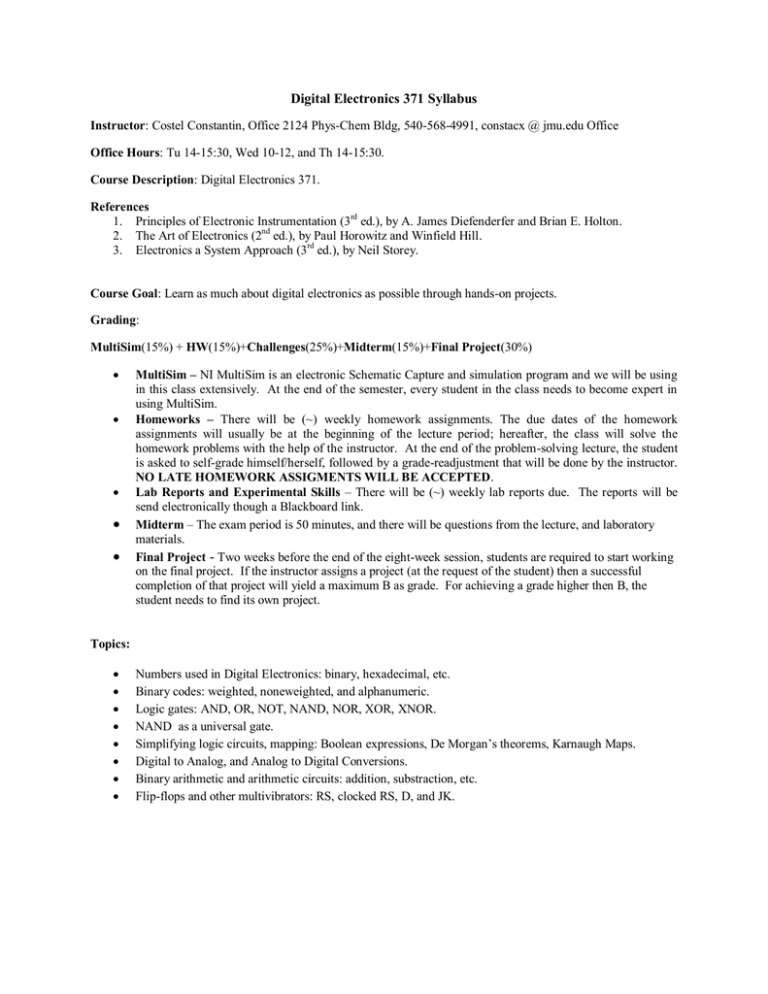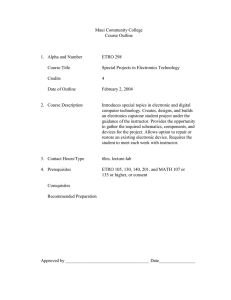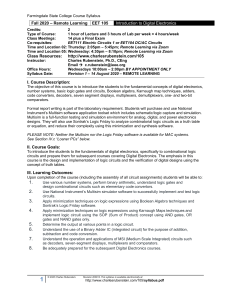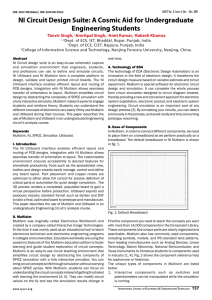PHYS 371:Digital Electronics
advertisement

Digital Electronics 371 Syllabus Instructor: Costel Constantin, Office 2124 Phys-Chem Bldg, 540-568-4991, constacx @ jmu.edu Office Office Hours: Tu 14-15:30, Wed 10-12, and Th 14-15:30. Course Description: Digital Electronics 371. References 1. Principles of Electronic Instrumentation (3rd ed.), by A. James Diefenderfer and Brian E. Holton. 2. The Art of Electronics (2nd ed.), by Paul Horowitz and Winfield Hill. 3. Electronics a System Approach (3rd ed.), by Neil Storey. Course Goal: Learn as much about digital electronics as possible through hands-on projects. Grading: MultiSim(15%) + HW(15%)+Challenges(25%)+Midterm(15%)+Final Project(30%) MultiSim – NI MultiSim is an electronic Schematic Capture and simulation program and we will be using in this class extensively. At the end of the semester, every student in the class needs to become expert in using MultiSim. Homeworks – There will be (~) weekly homework assignments. The due dates of the homework assignments will usually be at the beginning of the lecture period; hereafter, the class will solve the homework problems with the help of the instructor. At the end of the problem-solving lecture, the student is asked to self-grade himself/herself, followed by a grade-readjustment that will be done by the instructor. NO LATE HOMEWORK ASSIGMENTS WILL BE ACCEPTED. Lab Reports and Experimental Skills – There will be (~) weekly lab reports due. The reports will be send electronically though a Blackboard link. Midterm – The exam period is 50 minutes, and there will be questions from the lecture, and laboratory materials. Final Project - Two weeks before the end of the eight-week session, students are required to start working on the final project. If the instructor assigns a project (at the request of the student) then a successful completion of that project will yield a maximum B as grade. For achieving a grade higher then B, the student needs to find its own project. Topics: Numbers used in Digital Electronics: binary, hexadecimal, etc. Binary codes: weighted, noneweighted, and alphanumeric. Logic gates: AND, OR, NOT, NAND, NOR, XOR, XNOR. NAND as a universal gate. Simplifying logic circuits, mapping: Boolean expressions, De Morgan’s theorems, Karnaugh Maps. Digital to Analog, and Analog to Digital Conversions. Binary arithmetic and arithmetic circuits: addition, substraction, etc. Flip-flops and other multivibrators: RS, clocked RS, D, and JK. Equipment: Equipment will be provided for work in the lab. This equipment is to be used exclusively in the lab. NO EQUIPMENT MAY BE TAKEN FROM THE LAB WITHOUT WRITTEN PERMISSION OF THE INSTRUCTOR. Laboratory Safety: As with any lab safety is an issue. This lab is not subject to many hazards but accidents result whenever people become careless. Common sense and care are mandatory in any laboratory. Safety Specifics: Circuits may become very hot! The most common hazard in this lab is from circuits that over-heat when improperly connected. Wiring elements in a circuit invariably involves mistakes. You may fry some components. Components can burn and smoke. LEDs can pop. Components may become hot enough to burn your finger. Be aware of this and look for signs that components may be overheating. Often, the first warning is that you smell it. UNPLUG YOUR POWER SUPPLY if you think a circuit is overheating. No bare feet in the lab. Occasionally integrated circuits are dropped on the floor, and they nearly always land with the pins pointing up. If you should step on one in bare feet, you will regret it. Soldering Irons Melt Solder and Skin! Allow adequate space, and use a well-controlled and comfortable work area, with good ventilation. Turn off the iron when done. Be aware that solder and the iron become very hot and burn quickly. Also, be sure to keep the electric cord of the iron away from the hot tip. No food or beverages in the lab: This is a rule recently imposed by OHSA.



